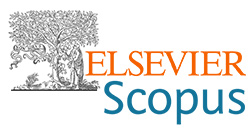Hydrothermal synthesis of bioactive calcium silicate glass
DOI:
https://doi.org/10.62638/ZasMat1049Apstrakt
This work presents the synthesis of bioactive glass 60SiO2-40CaO (wt.%) by the hydrothermal method without using acid catalysts in a shortened synthesis time. The precursors Si(OC2H5)4 (TEOS), Ca(NO3)2.4H2O were introduced in a hydrothermal system, and heated at 150 oC for 24 hours. The resulting gel was dried at 150 oC for 24 hours, then calcined at 800 oC for 3 hours to achieve bioactive glass. Several physical-chemical methods such as TG-DSC, XRD, SEM, and ICP-OES were used to evaluate the synthetic material. The bioactivity and biocompatibility of synthetic glass were evaluated by in vitro experiments in SBF solution and in cell culture environment. The obtained results show that the synthetic glass is an amorphous material, presenting bioactivity through the formation of a hydroxyapatite mineral layer after 10 days of soaking in SBF solution, and also showing good biocompatibility with cells L-929.
Ključne reči:
Bioactive glass, bioactivity,, artificial bone, hydroxyapatite, cell viabilityReference
L. L. Hench (1991) Bioceramics: From Concept to Clinic, Journal of the American Ceramic Society, 74(7), 1487-1510. https://doi.org/10.1111/j.1151-2916.1991.tb07132.x
L. L. Hench, R. J. Splinter, T. K. Jr. Greenlee (1971) Bonding Mechanisms at the Interface of Ceramic Prosthetic Materials, Journal of Biomedical Materials Research, 5(6), 117-141. https://doi.org/10.1002/jbm.820050611
J. Ma, C. Z. Chen, D. G. Wang, X. G. Meng, J. Z. Shi (2010) Influence of the sintering temperature on the structural feature and bioactivity of sol-gel derived SiO2-CaO-P2O5 bioglass, Ceramics International, 36(6), 1911-1916. https://doi.org/10. 1016/j.ceramint.2010.03.017
T. Kokubo, H. Takadama (2006) How useful is SBF in predicting in vivo bone bioactivity, Biomaterials, 27(15), 2907-2915. https://doi.org/10.1016/ j.biomaterials.2006.01.017
G. J. Owens, R. K. Singh, F. Foroutan, M. Alqaysi, C. M. Han, C. Mahapatra, H. W. Kim, J. C. Knowles (2016) Sol–gel based materials for biomedical applications, Progress in Materials Science, 77, 1-79. https://doi.org/10.1016/j.pmatsci.2015.12.001
Z. Hong, A. Liu, L. Chen, X. Chen, X. Jing (2009) Preparation of bioactive glass ceramic nanoparticles by combination of sol–gel and coprecipitation method, Journal of Non-Crystalline Solids, 355(6), 368-372. https://doi.org/10.1016/j.jnoncrysol.2008.12.003
I. Elgayar, A. E. Aliev, A. R. Boccaccini, R. G. Hill (2005) Structural analysis of bioactive glasses, Journal of Non-Crystallization Solid, 361(2), 173-183. https://doi.org/10.1016/j.jnoncrysol.2004.07.067
T.J. Mosmann (1983) Rapid colorimetric assay for cellular growth and survival: Application to proliferation and cytotoxicity assays, Journal of Immunological Methods, 65, 55–63. https://doi.org/10.1016/0022-1759(83)90303-4
B.T. Hoa, H.T.T. Hoa, N.A. Tien, N.H.D. Khang, E.V. Guseva, T.A. Tuan, B.X. Vuong (2020) Green synthesis of bioactive glass 70SiO2-30CaO by hydrothermal method, Materials Letters, 274, 128032. https://doi.org/10.1016/j.matlet.2020.128032
A. Saboori, M. Rabiee, F. Moztarzadeh, M. Sheikhi, M. Tahriri, M. Karimi (2009) Synthesis, characterization and in vitro bioactivity of sol-gel-derived SiO2–CaO–P2O5–MgO bioglass, Material Science Engineering C, 29, 335–340. https://doi.org/10.1016/j.msec.2008.07.004
A.M. El-Kady, A.F. Ali (2012) Fabrication and characterization of ZnO modified bioactive glass nanoparticles, Ceramic International, 38, 1195–1204. https://doi.org/10.1016/j.ceramint.2011.07.069
J.R.L. Delben, K. Pereira, S.L. Oliveira, L.D.S. Alencar, A.C. Hernandes, A.A.S.T. Delben (2013) Bioactive glass prepared by sol–gel emulsion, Journal of Non-Crystalline Solids, 361, 119–123. https://doi.org/10.1016/j.jnoncrysol.2012.10.025
J. Román, S. Padilla, M. Vallet-Regí (2003) Sol- gel glasses as precursors of bioactive glass ceramics, Chemistry of Materials, 15, 798–806. https://doi.org/10. 1021/cm021325c
T.A. Tuan, E.V. Guseva, L.H. Phuc, N.Q. Hien, N.V. Long, B.X. Vuong (2020) Acid-free Hydrothermal Process for Synthesis of Bioactive Glasses 70SiO2–(30-x)CaO–xZnO (x = 1, 3, 5 mol.%), Proceeding, 62,1–12. https://doi.org/10.3390/proceedings2020062006
[15] I. Cacciotti, M. Lombardi, A. B. Antonio, L. Montanaro (2012) Sol–gel derived 45S5 bioglass: synthesis, microstructural evolution and thermal behaviour, Journal of Material Science: Material Medicine, 23(8), 1849-1866. https://doi.org/10.1007/s10856-012-4667-6
[16] S. M. Ahmadi, A. Behnamghader, A. Asfnejaad (2017) Sol-gel synthesis, characterization and in vitro evaluation of SiO2-CaO-P2O5 bioactive glass nanoparticles with various CaO/P2O5 ratios, Digest Journal of Nanomaterials and Biostructures, 12(3), 847-860. https://doi.org/10.1016/j.ceramint.2015.12.128
N. Letaief, H. Oudadesse (2014) New 92S6 mesoporous glass: Influence of surfactant carbon chain length on the structure, pore morphology and bioactivity, Materials Research Buleetin, 60, 882-889. https://doi.org/10.1016/j.materresbull.2014.08.048
V. Aina, G. Malavasi, A.F. Pla, L. Munaron, C. Morterra (2009) Zinc-containing bioactive glasses: Surface reactivity and behavior towards endothelial cells, Acta Biomaterialia, 5, 1211–1222. https://doi.org/10.1016/j.actbio.2008.10.020
I.Y. Kim, G. Kawachi, K. Kikuta, S.B. Cho, M. Kamitakahara, C.J. Ohtsuki (2008) Preparation of bioactive spherical particles in the CaO–SiO2 system through sol–gel processing under coexistence of poly (ethylene glycol), Journal of the European Ceramic 28, 1595–1602. https://doi.org/10.1016/j.jeurceramsoc.2007.11.006
P.J. Innocenzi (2003) Infrared spectroscopy of sol–gel derived silica-based films: A spectra-microstructure overview, Journal of Non-Crysta-lline Solids, 316, 309–319. https://doi.org/10. 1016/S0022-3093(02)01637-X
J. Ding, Y. Chen, W. Chen, L. Hu, G. Boulon (2012) Effect of P2O5 addition on the structural and spectroscopic properties of sodium aluminosilicate glass, Chinese Optics Letters, 10, 071602. https://doi.org/10.3788/col201210.071602
X.F. Chen, B. Lei, Y.J. Wang, N.J. Zhao (2009) Morphological control and in vitro bioactivity of nanoscale bioactive glasses, Journal of Non-Crystalline Solids, 355, 791–796. https://doi.org/10.1016/j.jnoncrysol.2009.02.005
Z. Hong, A. Liu, L. Chen, X. Chen, X.J. Jing (2009) Preparation of bioactive glass-ceramic nanoparticles by combination of sol–gel and coprecipitation met¬hod, Journal of Non-Crystalline Solids, 355, 368–372. https://doi.org/10.1016/j.jnoncrysol.2008.12.003
A. Hoppe, N.S. Güldal, A.R. Boccaccini (2011) A review of the biological response to ionic dissolution products from bioactive glasses and glass-ceramics, Biomaterials, 32, 2757–2774. https://doi.org/10.1016/j.biomaterials.2011.01.004
I.A. Silver, J. Deas, M.E. Hska (2001) Interactions of bioactive glasses with osteoblasts in vitro: Effects of 45S5 Bioglass®, and 58S and 77S bioactive glasses on metabolism, intracellular ion concentrations and cell viability, Biomaterials, 22, 175–185. https://doi.org/10.1016/S0142-9612(00)00173-3







